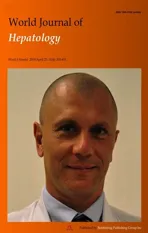Yes-associated protein at the intersection of liver cell fate determination
2019-12-21YongFengBaiSiWeiWangZhengCaiXuJinZhuFengZhang
Yong-Feng Bai, Si-Wei Wang, Zheng-Cai Xu, Jin Zhu, Feng Zhang
Abstract
Key words: Hybrid periportal hepatocytes; Yes-associated protein; SOX9; Epithelialmesenchymal transition; Hepatocellular carcinoma
TO THE EDITOR
The recent publication inHepatologyby Jianget aldescribed that nuclear pregnane X receptor (PXR) activates hybrid periportal hepatocyte (HybHP) cell proliferation through YAP and played a key role in liver regeneration following partial hepatectomy[1]. The authors found that HybHPs comprise a SOX9-positive, YAP-high cell population and that YAP is a key protein that regulates HybHP cell proliferation.Inhibition of YAP abolished PXR-induced liver enlargement in mice. HybHP was first characterized in 2015 as a pre-existing group of periportal hepatocytes in healthy livers[2]. These cells have low Sox9 (a progenitor cell marker) expression and hepatic gene features. Another study published several months ago examined the role of epithelial-mesenchymal transition (EMT) in liver regeneration[3]. They found that some hepatocytes overexpressed YAP during the repair process after liver damage and underwent an EMT-like process. YAP interacted with Smad2 in the TGF-β pathway to promote cell proliferation.
Although the names of the cell populations described in these articles (HybHP or EMT-reprogrammed hepatocytes) are different, they both express high levels of YAP.Even though whether such EMT-reprogrammed cells express SOX9 is unknown, EMT is an important pathway to generate progenitor cells. We hypothesize that the HybHP and EMT-reprogrammed hepatocytes described in these studies are a similar cell population. According to the contribution of these two cell types to liver regeneration and the high YAP expression, Hippo-YAP pathway activation may be a common regulatory pathway experienced by cells undergoing dedifferentiation and reactivating proliferative activity during liver regeneration, regardless of whether these highly proliferative cells are derived from hepatocytes or HybHP cells. YAP may be an effective target for promoting liver regeneration in liver failure patients.
Although no evidence showed that HybHP cells contribute to hepatocellular carcinoma (HCC) in three different mouse models[2], we cannot rule out the possibility that these highly regenerative cells can further develop into tumor cells or cancer stem cells when they gain mutations caused by viral infection or other risk factors like alcohol. YAP is activated in 50% of human HCCs, and its activation level correlates with decreased survival after resection. Endogenous YAP activation perturbs hepatocyte differentiation and maintains this state in advanced tumors, and YAP silencing restores hepatocyte differentiation and leads to tumor regression[4]. It is interesting to question whether YAP is activated during controlled liver regeneration and excessive cell proliferation is prevented by inactivating YAP. However, under pathological conditions, the control of YAP activity is disrupted, resulting in continuous YAP activation and the generation of HCC.
Hippo signaling is the primary signaling pathway that regulates YAP activity, and MST1/2 phosphorylation of large tumor suppressor 1 and 2 (LATS1/2) can inhibit YAP entry into the nucleus. However, LATS1/2 phosphorylation by MST1/2 is context- and cell type-dependent. Loss of MST1/2 in mouse embryonic fibroblasts does not significant affect LATS1/2 phosphorylation or activation[5]. Therefore, we hypothesize that liver regeneration under various conditions will eventually lead to divergent consequences, probably due to the duration of YAP activation regulated by Hippo-LATS1/2 pathway in a context- and cell type-dependent manner. A deeper understanding of this aspect may uncover the key to target YAP to promote liver regeneration in pathological conditions and to control its tumorigenicity at the same time.
杂志排行
World Journal of Hepatology的其它文章
- Leukocytoclastic vasculitis caused by hepatitis C virus in a liver transplant recipient: A case report
- Nonalcoholic fatty liver disease prevalence in an Italian cohort of patients with hidradenitis suppurativa: A multi-center retrospective analysis
- Effectiveness of venous thromboembolism prophylaxis in patients with liver disease
- Being accompanied to liver discharge clinic: An easy measure to identify potential liver transplant candidates among those previously considered ineligible
- Beneficial effects of losartan or telmisartan on the local hepatic renin-angiotensin system to counter obesity in an experimental model
- MicroRNAs contribute to ATP-binding cassette transporter- and autophagy-mediated chemoresistance in hepatocellular carcinoma
